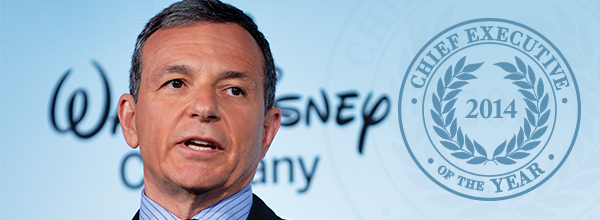CULTURE: HOW BOB IGER REMADE THE HOUSE 
CULTURE: HOW BOB IGER REMADE THE HOUSE
THAT WALT DISNEY BUILT
(Part 1 out of 4)
by J. P. Donlon

Few people
appreciate that when Walt Disney died in 1966, he left a company that was very
different from the one he started in 1923. Even Mickey Mouse had changed
numerous times over the years. Today, Bob Iger presides over The Walt Disney
Company, only the sixth CEO in its history, a very different company from the
one Walt knew; but in important ways, it is very much the same. The technology
and delivery may be different; but at its core, Disney remains an entertainment
company that’s all about memorable characters and storytelling.
When he became
CEO in October 2005, Iger faced a time of extended turmoil. The preceding five
years had been marked by a hostile takeover attempt, a shareholder revolt, a
board in conflict and years when performance fizzled. The once leading
animation department hadn’t had a hit in years. The brand had become somewhat
tarnished and employees no longer believed in Disney’s greatness. One of Iger’s
first tasks was to make peace with dissident shareholders Roy Disney and
Stanley Gold and to convince them to drop their lawsuit challenging the choice
of Eisner’s successor.
Once this
undertaking was behind him, Iger set about transforming Disney, surprising
friend and foe alike, since transformative change was not expected from an
insider. Having earned a degree in Television and Radio at Ithaca College, the
Long Island native began his career as a weatherman in Ithaca, New York and
moved up the ranks of network TV to become chairman at ABC. After Disney bought
the network in 1996, he became Eisner’s heir apparent. As he outlines in the
following interview at Disney’s Burbank studios, Iger quietly started to
implement a different vision.
What Disney
lacked, Iger sought to acquire. In 2006, the company bought Pixar Animation
Studios in a $7.4 billion deal he personally negotiated with Steve Jobs. In
2009, he negotiated a similar deal for Marvel Entertainment for $4 billion. In
2012, he hit the jackpot by convincing George Lucas to have Disney take over
Lucasfilm and the rights to Star Wars. (Star Wars VII is now in production). In
each case, Iger’s hands-off policy has allowed the individual units to continue
being creative. Certainly, the recent blockbuster Frozen, based on a Hans
Christian Andersen tale, which topped $1 billion at the box office worldwide,
suggest that Disney is on a tear.
The $45 billion
company with 175,000 employees has grown too large to be run from the top down.
It now comprises four divisions and five key brands, Disney, ESPN, ABC, Marvel
and Pixar. It also consists of cruises and theme parks around the world. The most
ambitious is Shanghai Disney, now under construction and due to open in 2015.
Observers reckon it will be Iger’s capstone achievement (his current contract
expires in June 2016).
The payoff has
been dramatic. During Iger’s tenure through the end of the 2013 fiscal year,
Walt Disney’s total shareholder return was 202 percent. In other words, if you
invested $100 at the beginning of his tenure, your investment would have been
worth $302 at the end of 2013. In addition, the company’s share price recently hit
an all-time closing high of $79.23 in February. The stock was just $23.81 when
Iger became CEO. What’s more, the company’s market cap reached $130 billion for
the first time ever.
Other recent
milestones from last year include:
- Revenues and profits reached new highs for three years running.
- Film releases generated the best box office results in Disney history.
- Record attendance at company theme parks in California, Florida, Tokyo and Hong Kong.
- Consumer products divisions posted its first $1 billion profit year—without fully benefiting from the Star Wars bonanza following the acquisition of Lucasfilm.
- In addition to Disney’s animation app for iPad, six of the 10 most popular downloads on Amazon Kindle were Disney apps. ESPN’s user traffic on mobile devices exceeded that on desktops.
With the
possibility of Iger’s stepping down less than two years off, the contest over
who will replace him looms. The departure of Disney Media Networks co-chairman
Anne Sweeney, one of the company’s two top television executives—along with
ESPN head John Skipper—focuses the spotlight more intensely on two candidates:
resorts chairman Thomas Staggs and CFO Jay Rasulo. In 2010, Iger had the two
switch jobs, a move that gave Staggs his first operational experience and
Rasulo involvement in financial decision-making.
Fuente: Chief Executive
Haciendo click en cada uno de los links siguientes,
accederán a los Contenidos de nuestros
TALLERES DE CAPACITACIÓN IN COMPANY A MEDIDA:
(translator on page)
¿Cómo INCORPORAR y APLICAR Modelos de
PENSAMIENTO ESTRATÉGICO?
PENSAMIENTO ESTRATÉGICO?
http://msg-latam-meic.blogspot.com.ar/2014/06/capacitacion-in-company-programa_6246.html
¿Cómo GERENCIAR EFICAZMENTE a partir del
MANAGEMENT ESTRATÉGICO?
http://msg-latam-meic.blogspot.com.ar/2014/06/capacitacion-in-company-programa_3.html
¿Cómo GERENCIAR PROCESOS DE CAMBIO
y no sufrir en el intento?
y no sufrir en el intento?
http://msg-latam-meic.blogspot.com.ar/2014/06/capacitacion-in-company-programa.html
¿Cómo IMPLEMENTAR ESTRATEGIAS EFECTIVAS?
Recetas para Escenarios Turbulentos
http://msg-latam-meic.blogspot.com.ar/2014/06/capacitacion-in-company-taller-de.html
Consultas al mail: msg.latam@gmail.com
ó al TE: +5411-3532-0510





















